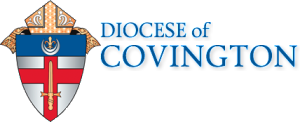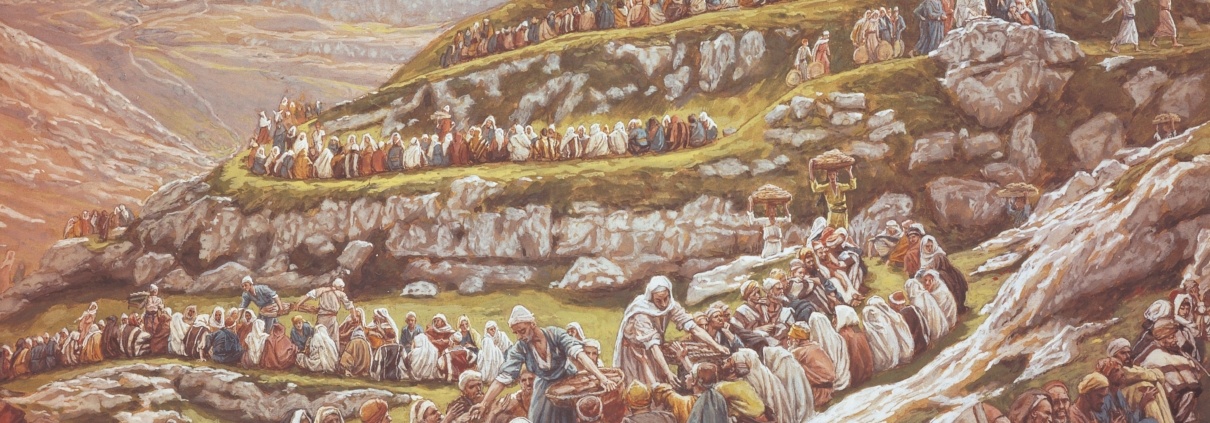The feeding of the five thousand and the Eucharist
By Father Ryan Stenger.
The only one of the miracles of Jesus that is included in all four of the Gospel accounts is his feeding of the crowd of five thousand with miraculously multiplied bread and fish. Obviously this event greatly affected the first Christians and was influential in forming their understanding of the Lord’s identity and mission.
In the Gospel according to John, the miracle of the feeding of the five thousand is reported at the beginning of the sixth chapter and is followed by the Lord’s famous Bread of Life discourse, in which Christ explains to the crowd his teaching on the Eucharist, thus drawing a strong connection between the miraculous feeding of the crowd and the sacrament of his Body and Blood that he would institute at the Last Supper. The evangelist also emphasizes this connection in his description of the time and place of the miracle. St. John writes, “Jesus went up on the mountain, and there he sat down with his disciples” (John 6:3). So often throughout the Bible the mountaintop is where God and man come together most profoundly. Moses received the Ten Commandments on Mt. Sinai, the prophet Elijah spoke to God in the silent whisper on Mt. Horeb, Christ himself was transfigured in glory on Mt. Tabor, and crucified on Calvary. According to the ancient imagination, the mountain was the place where heaven and earth meet, the symbol of God reaching down to us as we reach up to him.
And St. John also writes, “The Jewish feast of Passover was near” (John 6:4). It was on Passover that the sacrificial lambs were put to death in remembrance of God’s liberation of the Jewish people from slavery in Egypt. Of course, Christ would die on the Cross at Passover time, as the true Lamb of God whose sacrifice saves us from death and liberates us from slavery to sin. And so, with these details, St. John is showing that the miracle that Christ performed in feeding this massive crowd was not simply a matter of providing ordinary food, but that it was symbolic of something much more, that the bread he gave them prefigured the Bread of Life about which he would go on to teach them, the Eucharist — the place where heaven and earth meet, the unbloody re-presentation of the sacrifice of the Cross, the Lord’s sacred Body offered up and his precious Blood poured out.
It’s easy to imagine that enormous crowd of five thousand following the Lord across the Sea of Galilee and up the mountain. They surely must have been hungry and weary and maybe even lost and confused. How many times throughout their lives had they sought for a way to satisfy their hunger, for a place to find rest, for a source of guidance and direction, but been left unfulfilled in the end? But now they have come to Christ. And after they have been fed by him, St. John tells us that they “had their fill” and still there were twelve baskets of bread left over (John 6:12). That crowd stands for all of mankind, because we all have a profound spiritual hunger, a longing for more than what the world can give. Our hearts reach out towards the infinite, the transcendent, the divine, because God has made us for himself. Only in him are we able to have our fill, so to speak.
And it is in the Eucharist that he gives himself to us as food to sustain us on our journey towards him, as the only food that is able to satisfy that most fundamental longing of our hearts. If it were merely a symbol, it would not be enough, but the Lord gives himself to us truly in the Eucharist — his Body and Blood, his soul and divinity. And he gives himself to us not simply in a momentary way during the liturgy, but he remains with us always in the Tabernacle. His presence abides in our midst; he lives within his Church, so that we always have access to him, so that we’re always able to find our sustenance in communion with him.
The Second Vatican Council taught that the Eucharist is the source and summit of the whole Christian life (Lumen Gentium, n. 11). It is in the Eucharist that God lives among us — from him do our lives come and to him are our lives directed. He must indeed be the source and summit of our lives, as a Church, as a diocese, as parishes, as families, as individuals. But sometimes we lose sight of that. It seems so common to hear the Church spoken of as a sort of social service agency, which exists to run hospitals, and schools, and soup kitchens, but then for it to be forgotten that her primary purpose, the reason for all of her activity, is the worship of God. A parish, for example, can do all sorts of great things, but if it doesn’t draw its people closer to Christ in the Eucharist, then it has completely failed in its mission. And it is the same way in our individual lives. We can become so consumed with activity and busy-ness, even good and important and necessary things, that we lose sight of God living in our midst, that we sometimes even tell ourselves that we don’t have time to spend with him and worship him. Sometimes we look for our sustenance and satisfaction in other places; sometimes we direct our lives to other ends.
But the Lord’s miraculous feeding of the five thousand reminds us that only he can truly feed us, only he can satisfy the restlessness of our hearts. May we never look for our happiness apart from him who lives with us always in the Eucharist, so that we might live at all times with him as the source and summit of all that we do.
Father Ryan Stenger, J.C.L., is pastor, St. Joseph Parish, Camp Springs; and judge, Diocesan Tribunal Office.



